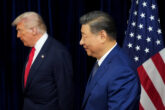June 06, 2024
Open Source AI: The Overlooked National Security Imperative
Today’s digital world is built on the back of innovative open source solutions like Linux or Python. Across sectors, from critical government infrastructure to academia to industry, the open source movement has played a pivotal role in driving technological progress forward.
The AI-driven world of the future is no different — it will be highly dependent on the widespread availability of open source models.
Now a global technological superpower, China does not want to repeat the mistakes of its past and is actively positioning itself to be the world’s AI leader.
This has clear national security implications. Whoever builds, maintains, or controls the global open source AI ecosystem will have a powerful influence on our shared digital future. It is therefore imperative for Western technology companies to maintain a leading position in the development and implementation of cutting-edge open source AI solutions.
Unfortunately, concerns about AI safety are leading many Western policymakers to develop new proposals that limit the abilities of businesses and academic institutions to develop AI in a transparent and open source manner. Though the West is not united, across regulatory regimes, governments are having serious debates about the future of AI and whether or not it will be open or closed.
Undermining the West’s ability to develop, distribute, or contribute to open source AI systems sets the stage for China to extend its influence into the world’s developing AI infrastructure. Such a future would be embedded with China’s techno-authoritarian values, rather than Western democratic ones. As Chinese startups have already begun to “win the open source AI race,” this is a future that may soon be here.
Read the full article from Just Security.
More from CNAS
-
Transatlantic Security / Technology & National Security
Look Before We Leap on Artificial IntelligenceThis article was originally published on The Dispatch. A debate about the role that artificial intelligence should and will play in society, and how it will affect humanity fo...
By Jon B. Wolfsthal
-
Technology & National Security
Caleb Withers on the Cybersecurity Frontier in the Age of AICaleb Withers, research associate at the Center for a New American Security, joins Kevin Frazier, the AI Innovation and Law Fellow at the University of Texas School of Law and...
By Caleb Withers
-
Technology & National Security
Prepared, Not ParalyzedExecutive Summary The Trump administration has embraced a pro-innovation approach to artificial intelligence (AI) policy. Its AI Action Plan, released July 2025, underscores t...
By Janet Egan, Spencer Michaels & Caleb Withers
-
Indo-Pacific Security / Technology & National Security
Sharper: Tech + ChinaRecent talks between President Donald Trump and Chinese Communist Party General Secretary Xi Jinping placed a spotlight on emerging technologies, from high-end chips to minera...
By Charles Horn & Sevi Silvia




